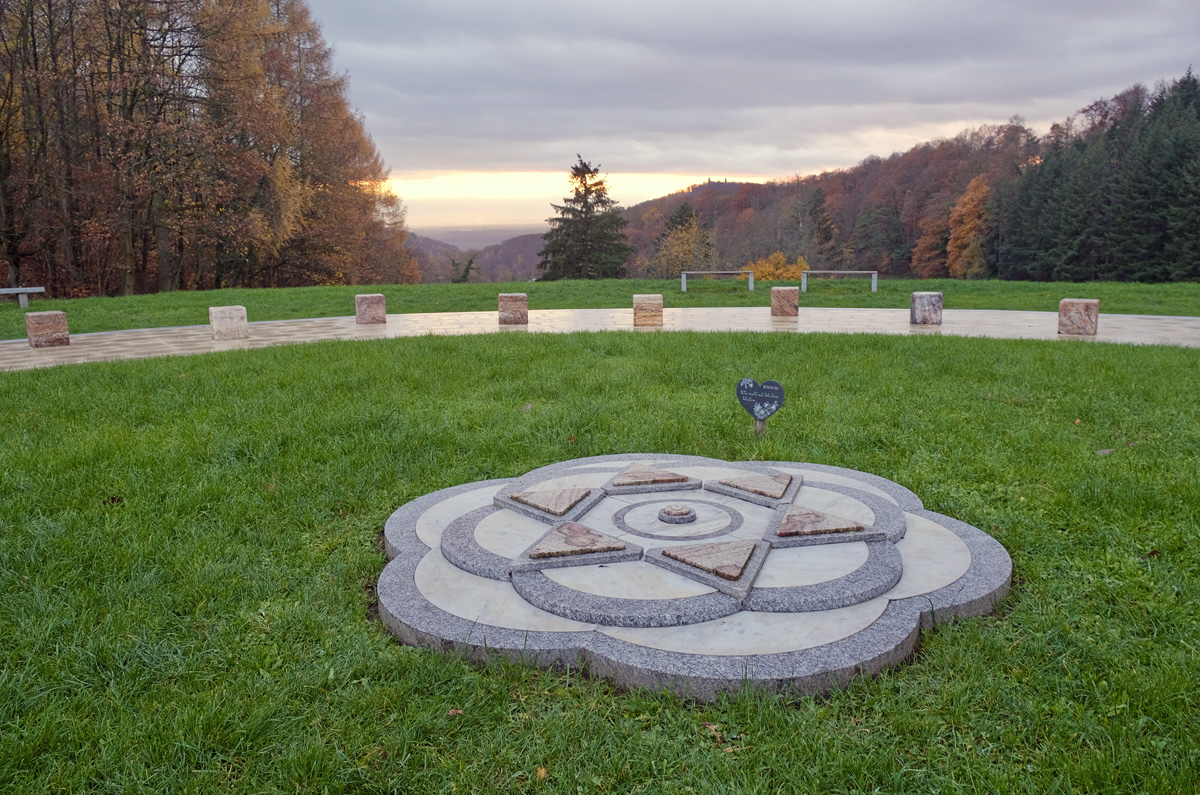Love is the only Revolution
Preface
The
Friedensmal of Change is a vivid example of how art, philosophy, and spirituality can work together to create a deeper meaning and higher consciousness for peace and freedom. It is a place of reflection and inspiration, inviting each individual to contemplate their role in society and the responsibility for collective well-being.The various chapters of this website illuminate the multifaceted aspects of the project, from the significance of cultural roots to the necessity of education towards freedom. They demonstrate that peace and freedom are not just external states but internal qualities that can be fostered through self-awareness and personal responsibility.
The Friedensmal is a symbol of hope for the future. It invites us not to dwell in the heaviness of the dark chapters of history but to recognize that a better future is possible through conscious efforts and collective responsibility. It is a place that promotes the values of humanity, tolerance, and mutual respect, thereby offering an impressive example of what can be achieved when people commit to the cause of peace and freedom.
The location of the Friedensmal on the European long-distance hiking trail No. 8 underscores the universal significance of this message and invites people from Europe and all over the world to be part of this vision. In a time of global challenges, it offers an inspiring perspective on the possibilities of human action and shows that the path to peace and freedom is also an inward journey, starting with the willingness to see oneself and the world with new eyes.
Thus, the Friedensmal is more than just a place; it is an idea, a vision, and a call to action. It challenges us all to take seriously the responsibility for our own freedom and the freedom of others, and to actively participate in shaping a better, more peaceful world. It is a living testament that peace and freedom can be not only dreamed of but also realized if we are ready to act.
The Friedensmal on the Hiking Trail
The expansive ensemble on the European long-distance hiking trail No. 8 comprises the large circular Friedensmal, situated in the Garden of Freedom, symbolizing the beauty and dignity of life. At its entrance and border is the Stone of Encounter. In the center of the Friedensmal, as a symbol of the heart, one sees the Blossom of Life, in whose center the Hebrew word 'Chai', meaning 'alive', is inscribed in marble.Our society needs reconciling symbols for positive cultural identification and for transformation, which provide support and encouragement. The Friedensmal along the hiking trail brings people and cultures together. It encourages standing up for the values of freedom and life, and it strengthens the belief that it is love that liberates. Love and peace are intensely felt at this place of power. Love generates a revolution in the heart, the only revolution that can free the world.
Overview of the Symbolism

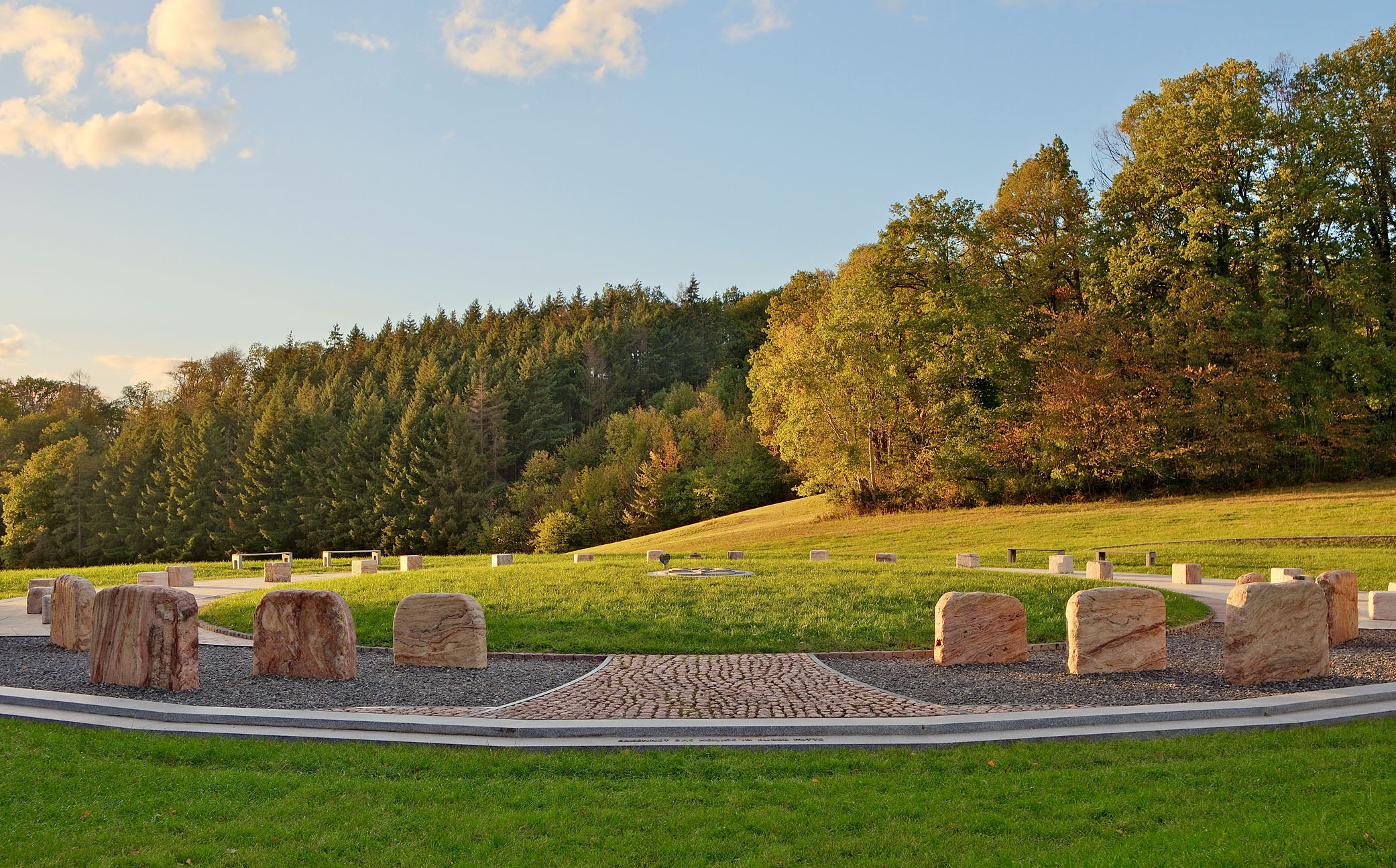
The Friedensmal is shaped like a 24-sided polygon. This symbolizes that one can walk around it all day – and every day – always returning to the starting point. It illustrates the idea that on the path of self-discovery, one can continually revolve in circles around oneself - until finally pausing. Entering inward, over the 'threshold of humility', marked by the inscription
'Recognize the Sacred in Your Midst', one steps into the heart of the monument and symbolically finds oneself in the 'Tree of Life'.The 11 large stones in the foreground symbolize the painful past within the 'dark ring of the alienated mind,' which, however, is 'broken from within' by the 'Tree of Life'. The 22 cubes in the ring around the 'crown of the tree' are inscribed with 'values in coexistence', where the artist was inspired by 22 perspectives on the theme corresponding to the 22 Hebrew letters. These values represent a sustainable future in coexistence. From the Friedensmal, it is also 22 km as the crow flies to Worms, the middle city of the former 'Jerusalem on the Rhine' with its significant Jewish past. Learn more about the name 'Jerusalem' in connection with the Friedensmal, particularly addressing the German-Jewish history, in the chapter 'Stone of Encounter'.
Video: Flight over the Friedensmal
Elements and Symbols of the Friedensmal
The following provides an overview of the key elements and symbols of the Friedensmal. They are not only aesthetically and spiritually significant but also have profound social and cultural implications. In the 'Project' menu, you will find detailed descriptions of these elements.
The Friedensmal - for the Inner Journey to Life

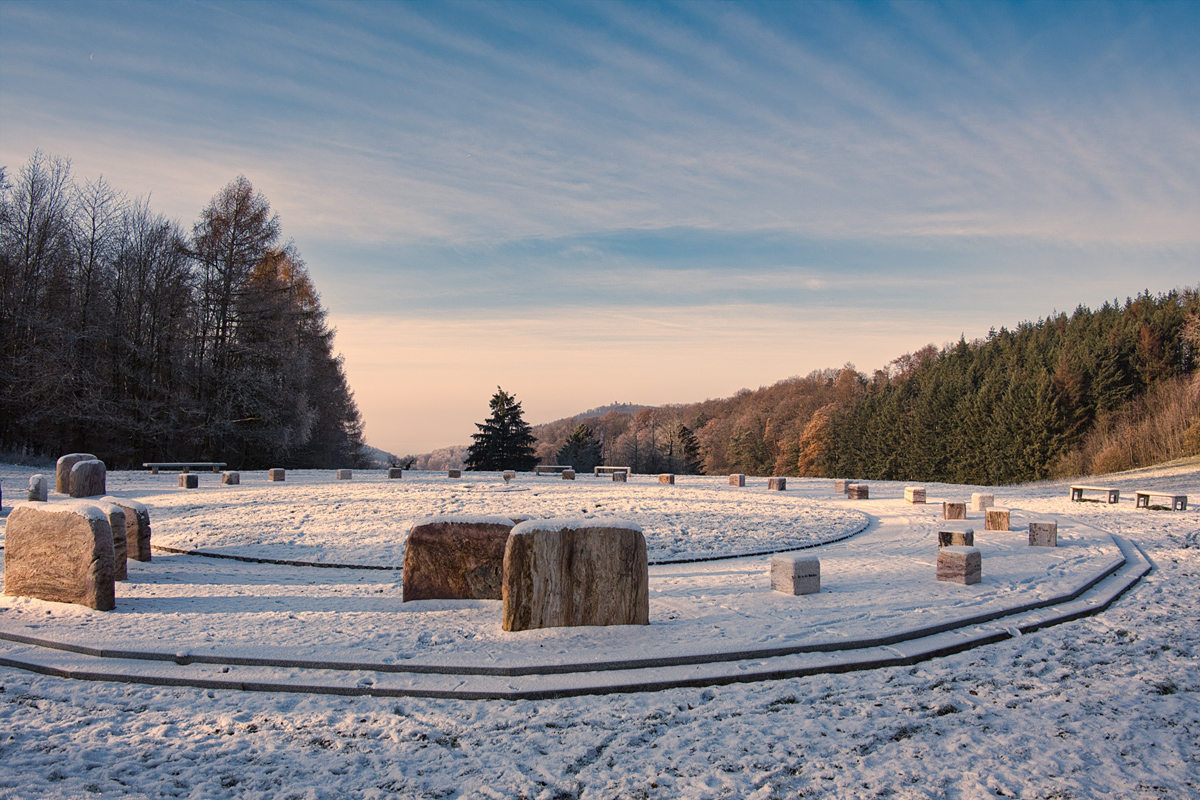
As you walk around the circle of the
Eckhart Tolle describes what the Tree of Life in the Friedensmal signifies in his book 'Stillness Speaks': It’s a dimension of consciousness deeper than thought, which could be called awareness, presence, or unconditioned consciousness. It is the very essence of who one is.
11 large stones in the 'Dark Ring' symbolize the blockages and entanglements that stand between a person and their freedom on their journey to self. It represents the mind of the traumatized human. Those who are not free are identified with their entanglements, thereby contributing to the world being as it is today. The liberation from these entanglements is symbolized in the Friedensmal by the Tree of Life, which breaks through the Dark Ring.
The 12th stone, the Stone of Encounter (outside), stands outside the Friedensmal circle on the European long-distance hiking trail. It represents a responsibility for peace and freedom in the outside world. It is '... a call full of love for the freedom of mankind' (inscription).
The Friedensmal - Here you will find a detailed description of the symbolism.
The Garden of Freedom for a Culture of Freedom

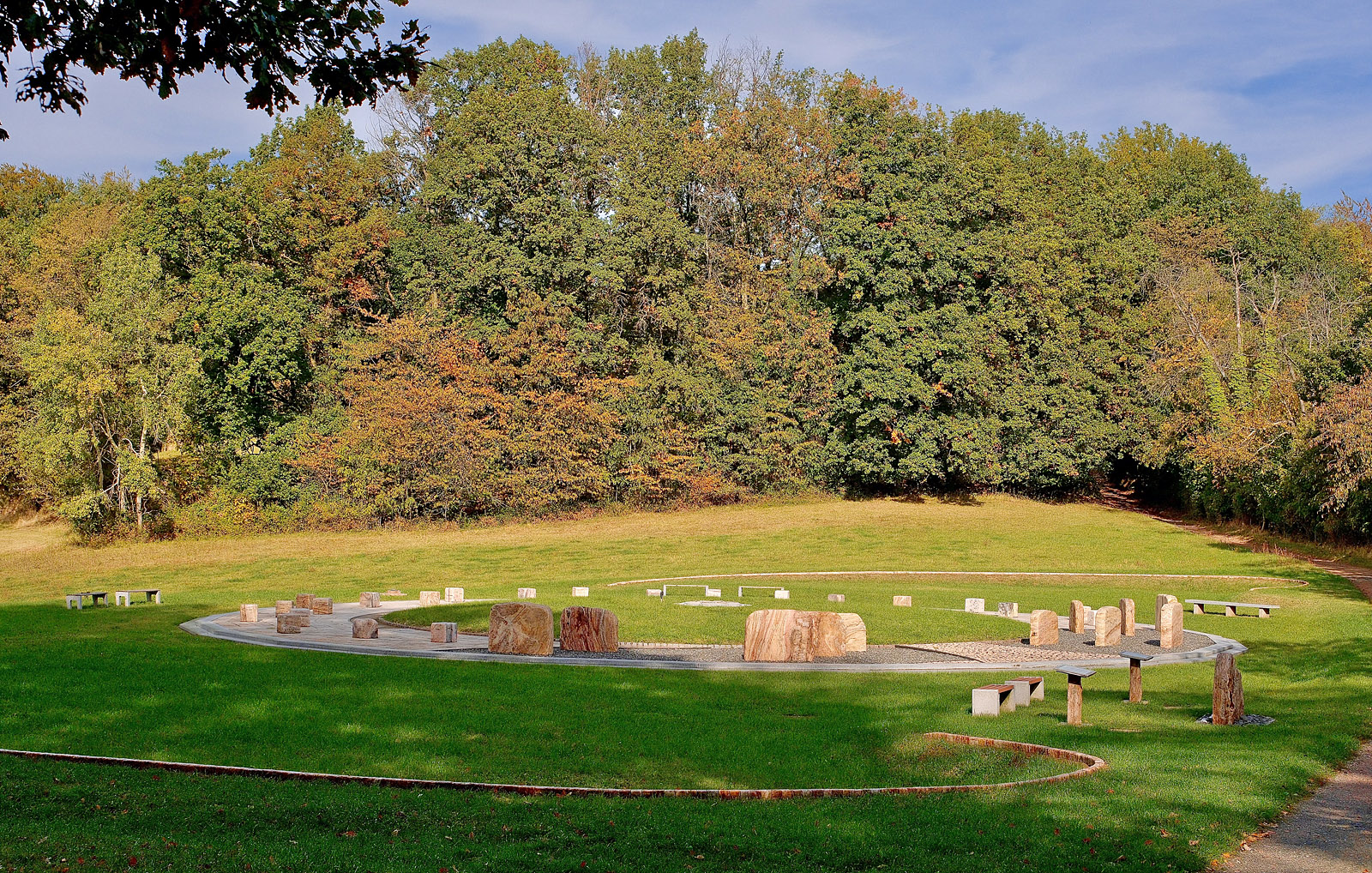
The
Freedom is not the absence of boundaries, but the conscious recognition of them. Freedom arises from the willingness to understand the effects of our actions on others. If we are indifferent in our actions to the consequences for our fellow human beings, true freedom remains unreachable. The source of freedom lies within us: It unfolds as we become aware of the ideological barriers that separate us from each other and from truth and life itself. In this context, the ego can be seen as a kind of 'ideological fence.' It is a collection of beliefs and convictions that shape our view of the world and our behavior, often in a way that cuts us off from a deeper connection with others and ourselves. Being aware of these 'ideological fences,' including the ego, is a crucial step towards a more authentic freedom.
Framed by its two 'angel wings,' the Garden of Freedom encompasses the 26-meter large Friedensmal. At the border to the European long-distance hiking trail No. 8 (the path through the world) is the Stone of Encounter with the inscription 'Yerushalayim' (Hebrew for Jerusalem) on the 'Side of Hope.' It corresponds to a healing impulse from German culture with 'Yerushalayim' - as Jews feel it - to engage in encounter. On the other side of the stone, the suffering of the past and present is addressed. Below it, a slate stone in the ground with the inscription 'Where Dust Turns to Light' points towards the Friedensmal.
The Garden of Freedom forms the framework of the Friedensmal. This enables contact with the environment and overcomes prejudices that a culture of remembrance had caused, which had focused much more on death than on life. This chapter with an overview and an explanation of the individual elements of the design serves as a solid introduction for understanding the project.
* Education for freedom gives us the tools to liberate ourselves from education (kokhavim) *
Stone of Encounter
- the dark and raw side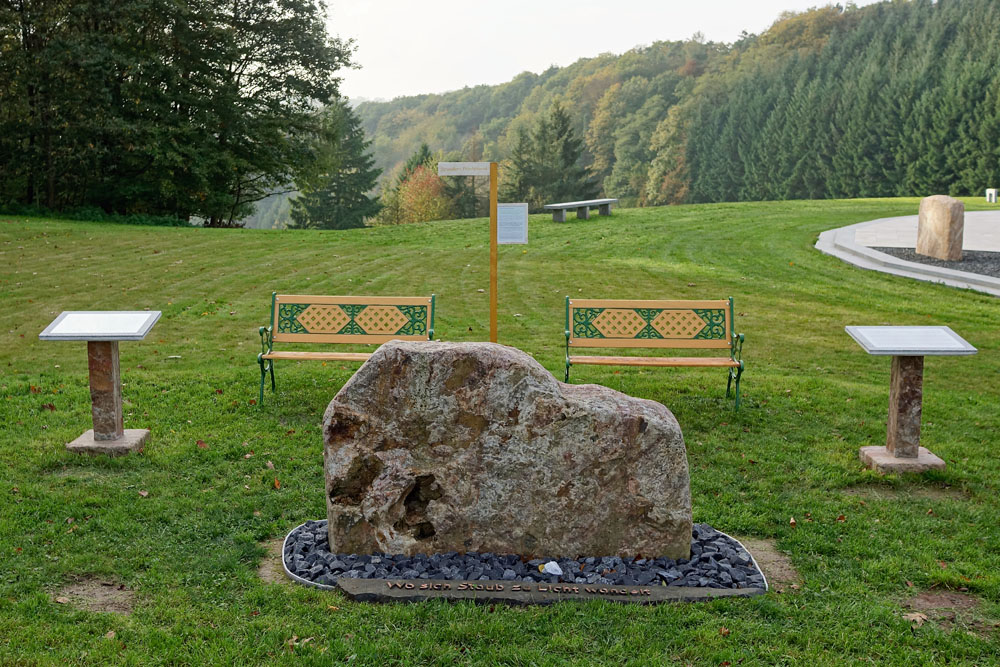
This is the 12th stone, the
Stone of Encounter. We look at the past, we remember who we truly are, and we meet the present. Life happens in the present: Where do we experience war and lack of freedom today instead of peace and freedom in our own lives? Where can we take responsibility for a more beautiful world? Where does our responsibility begin? A slate threshold under the stone, inscribed with 'Where Dust Turns to Light,' points to the Friedensmal to the right, which shows the path into our inner selves. It signifies a peace that one can find within and then carry outward into the world.The past at the location - The 12 years of Nazi rule, ultimately a collapse of civilization, is a wake-up call for a life in freedom; beyond the boundaries of an ideological prison.
Stone of Encounter
- The light and polished side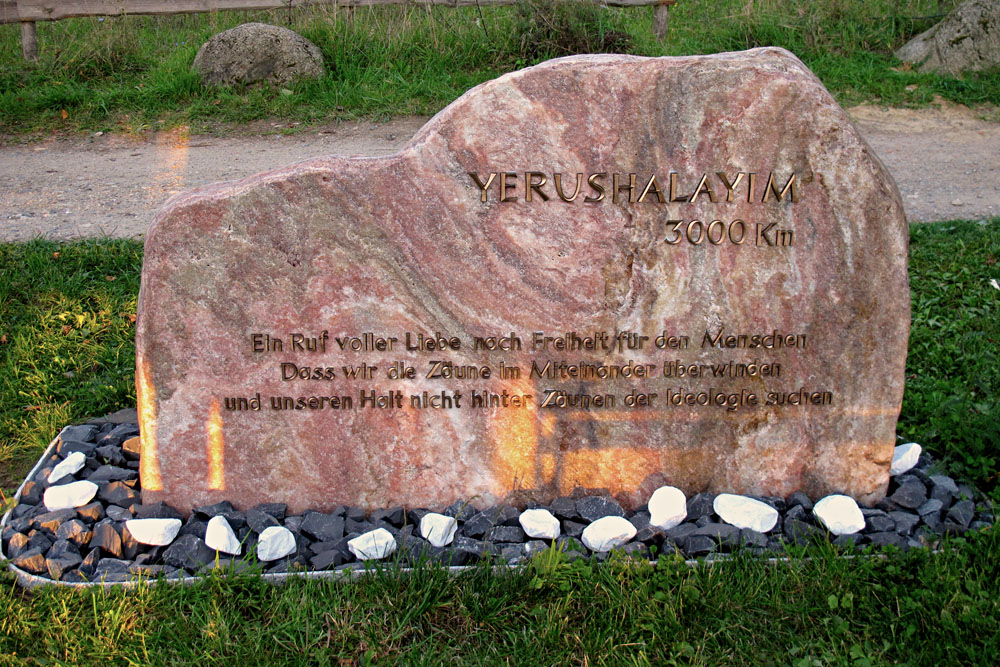
Inscription:
YERUSHALAYIM signifies the spiritual Jerusalem and connects us with a root that reaches deep into the origins of Judaism and has been deeply hurt throughout German history. This root forms an essential part of our European culture and history and is at the same time a symbol of the 'Other,' the foreign yet familiar. The presence of Yerushalayim on the Stone of Encounter at the Friedensmal serves a reminder of our complex and often complicated cultural identity, which is fed from various religious and philosophical traditions.
In 2013, this monument was inaugurated as the 'Jerusalem Friedensmal'. It was intended to promote peace in German-Jewish relations particularly. Given the lack of response in society and especially among established organizations from the political and religious sector, but the obvious need for peace and processing of traumas worldwide, the project freely evolved into the 'Friedensmal of Change'. This change opens the project to a broader audience and a diversity of experiences while ensuring that the origins of the project are valued and preserved in openness. Especially with the word 'Yerushalayim' on the Stone of Encounter, a strong reference is made to this German-Jewish past - including the 'Jerusalem on the Rhine' - which is burdened with trauma for both Jews and Germans. We invite everyone to participate in this place of encounter and change, and to build together a future of peace and reconciliation.
Behind the Stone of Encounter pointing towards Jerusalem, there is a fence symbolizing the importance of healthy boundaries. We do not build walls between us humans, and we do not tear down fences; rather, we are aware of the fences and recognize the light and beauty that they protect. In this context, Yerushalayim becomes a symbol of the connection between different cultures and traditions and a universal quest for peace and understanding. It reminds us that true harmony and understanding require both an awareness of our individual roots and our shared humanity.
Freedom is not the absence of boundaries, but the conscious recognition of them. Freedom arises from the will to understand the effects of our actions on others. If we are indifferent to the consequences of our actions for our fellow human beings, true freedom remains unattainable. The source of freedom lies within us: It unfolds when we become aware of the ideological barriers that separate us from each other, as well as from truth and life itself. In this context, the ego can be considered a kind of 'ideological fence.' It is a collection of beliefs and convictions that shape our view of the world and our behavior, often in a way that cuts us off from a deeper connection to others and to ourselves. Becoming aware of these 'ideological fences,' including the ego, is a crucial step on the path to more authentic freedom.
Encounter Stone - Here you will find a detailed examination of both sides of the large stone made of Odenwald quartz: the raw side with the suffering and burden of the past and the light, refined side that shows the sanctity of relationship. With the name 'Yerushalayim,' a root of our German culture is identified, and it is also a reference to the universal 'heavenly Jerusalem' a symbol for hope, healing, and global peace. This stone represents the overcoming of history through understanding, a symbol of healing and freedom and thus a hope for peace in the world.
The Blossom of Life for a Living Heart

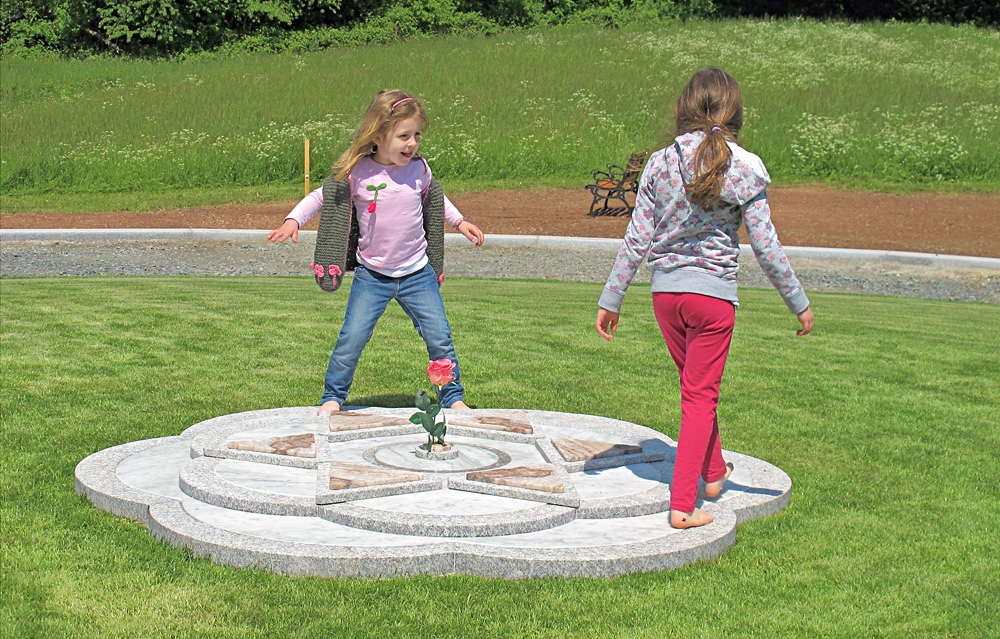
The
The Blossom of Life - Discover more about the universal symbolism of the 'Blossom of Life' and its significance in various spiritual traditions.
Jerusalem on the Rhine
A German-Jewish Story in World Heritage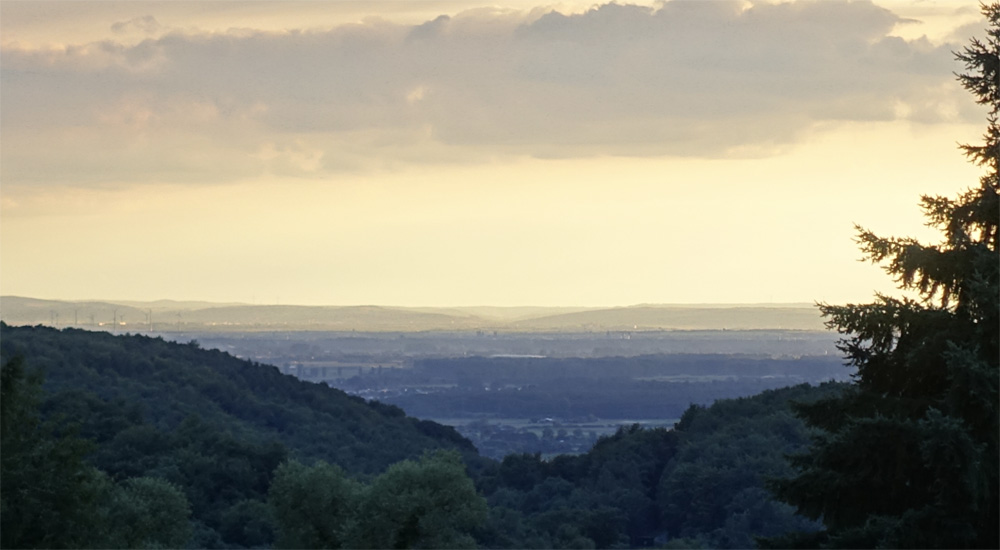
This place of contemplation is located on the European Long-Distance Hiking Trail on a hill near Bensheim, South Hesse. The history of '
From the Friedensmal the silhouette of Worms (22 km away), with its large cathedral, one of the three cities Speyer, Worms, and Mainz, which served as centers of Jewish life in the High Middle Ages, is visible. Due to their central importance for the Jewish communities in Central Europe, they are considered the birthplace of Ashkenazi Jewish culture in the High Middle Ages. These cities were both scenes of significant Jewish scholarship and pogroms and destruction. Their history teaches us about the difficulties and failures of different cultures living together, but also about the resilience and contribution of the Jewish community to European history.
This complex past of 'Jerusalem on the Rhine' serves as a cautionary example that cultural diversity and coexistence carry challenges, but also the possibility for understanding and mutual respect. It reminds us that the pursuit of a harmonious togetherness requires recognition of the past, clear boundaries, and the constant effort for mutual respect and understanding.
Jerusalem on the Rhine - Here you can find more information about this German-Jewish history.
Engagement and Participation
The Vision of the Friedensmal of Change
The Friedensmal is a living memorial that encourages reflection and inner transformation. It serves not only as a place for inner contemplation but also as a space for encounter and dialogue. It reminds us that peace is not just the absence of war, but a state of inner balance and harmony with the world around us. In a time when the world is plagued by conflicts and misunderstandings, the Friedensmal offers a space for healing and understanding. It is a project that is constantly growing and evolving, just like our collective pursuit of peace. Unlike traditional admonishing memorials in Germany, it takes a constructive and forward-looking approach. May the Friedensmal serve as an inspiration to us today and to future generations to continue the path to peace and freedom.
 The Friedensmal is a dynamic place for exchange and inspiration. We host a variety of events focused on themes such as peace, meditation, yoga, and dialogue. Your contribution is valuable: bring your ideas, create your own events, workshops, and meditations, or participate in existing offerings. We strive to understand peace not just as a concept, but to actively realize it in society. Every form of participation, especially through your visit and personal reflection at the Friedensmal, is meaningful and supports our common goal of a more peaceful world.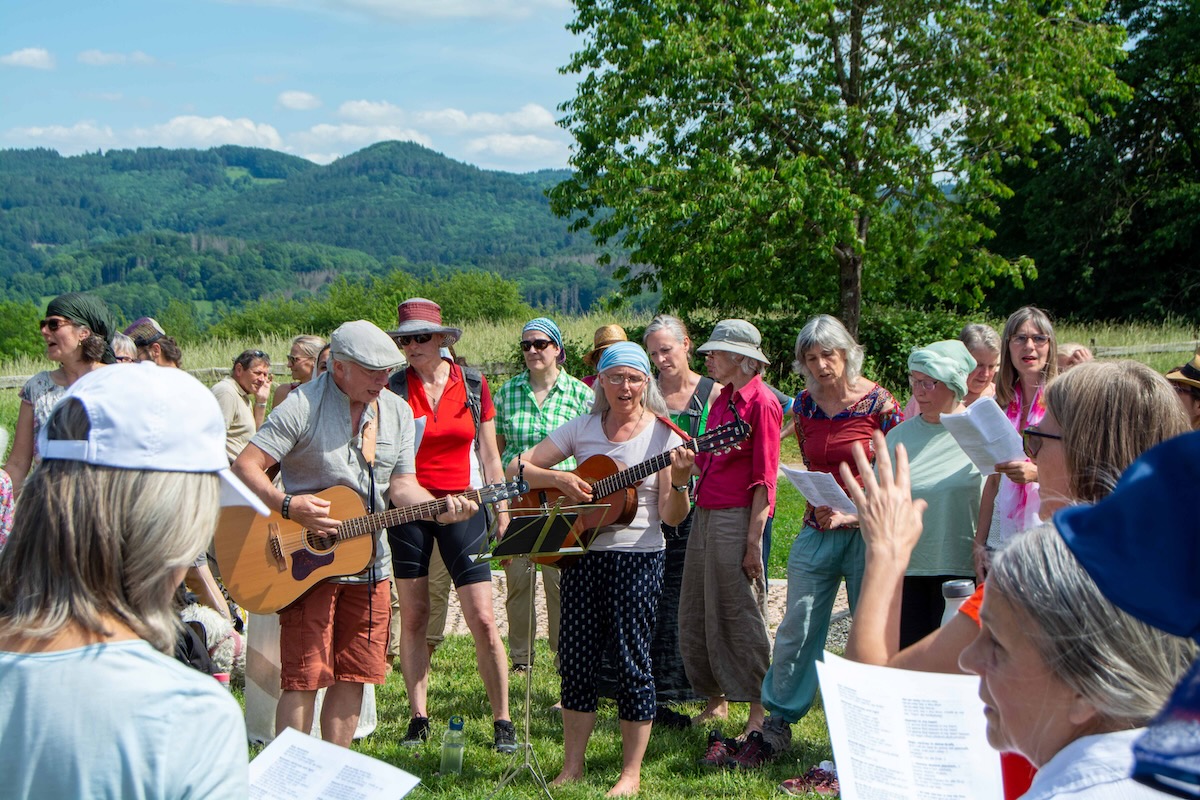
People from "Gemeinsam Genießen & Gestalten" (GG&G) from Seeheim sing at the Friedensmal during the inauguration ceremony
